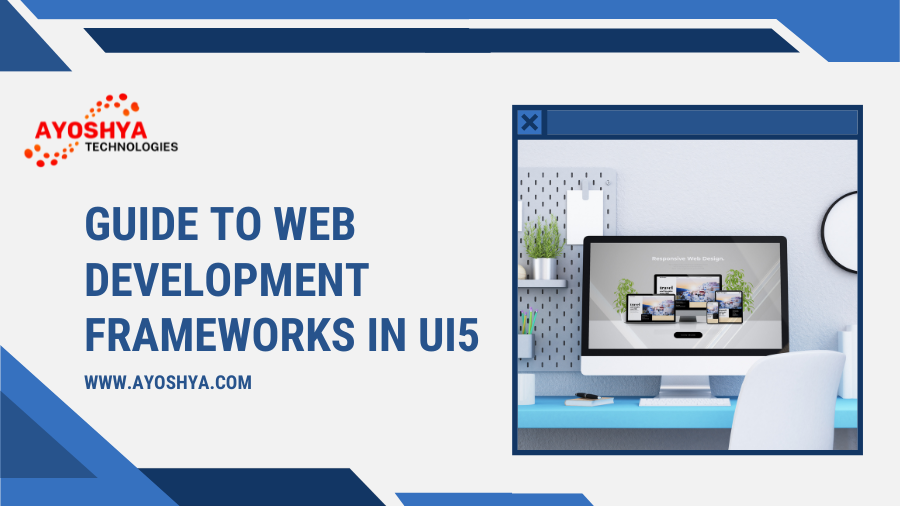A Comprehensive Guide to Web Development Frameworks in UI5
The vibrant ecosystem of web development thrives on frameworks, powerful platforms that provide structure, tools, and best practices for building impactful web experiences. In the realm of SAP solutions, SAPUI5 (SAP User Interface version 5) stands as a prominent player, empowering developers to create engaging and responsive applications. But within UI5 itself lies a labyrinth of options: different Web Development Frameworks in UI5 vying for your attention. Choosing the right one can feel overwhelming. This comprehensive guide unveils the secrets hidden within the UI5 labyrinth, illuminating the strengths and weaknesses of various Web Development Frameworks in UI5 to help you navigate towards the perfect match for your project.
Understanding the Landscape: Key Considerations for Choosing a Framework
Before embarking on your journey, consider these crucial factors that will guide your framework selection:
- Project Requirements: Identify the specific needs of your project, including desired functionalities, complexity, target audience, and performance expectations. A simple internal tool might need a different framework than a complex customer-facing web portal.
- Developer Skills and Resources: Assess your team’s expertise and familiarity with different frameworks. Choose one that aligns with their existing skillset or offers a gentle learning curve to avoid hindering development progress.
- Integrations and Ecosystem: Consider the need for integration with other SAP solutions or external platforms. Choose a framework with robust documentation, active community support, and readily available extensions or plugins to simplify integration tasks.
- Future Viability and Maintenance: Look for a framework with a strong track record, active development roadmap, and ongoing community support. You want a framework that will evolve alongside your needs and remain relevant for years to come.
Exploring the Options: Popular Web Development Frameworks in UI5
Now, let’s delve into the heart of the matter: exploring the most popular web development frameworks in UI5:
- OpenUI5: The “native” framework of UI5, maintained by SAP themselves. It offers extensive functionalities, tight integration with SAP solutions, and a mature ecosystem. However, its complexity can be daunting for beginners, and reliance on proprietary libraries can limit cross-platform compatibility.
- SAP Fiori Sandbox: A visual development environment built on top of OpenUI5, simplifying application development through drag-and-drop functionalities and pre-built components. Ideal for rapid prototyping and for users with limited coding experience, but offers less flexibility and customization compared to other frameworks.
- Webix: A lightweight, JavaScript-based framework with a modular architecture and extensive UI components. Provides excellent performance, cross-platform compatibility, and integration with various backend technologies. However, its UI5 integration requires additional libraries and its learning curve can be steeper than OpenUI5.
- Vaadin: A Java-based framework offering rapid development using UI components and server-side rendering. Integrates seamlessly with Java backend systems and provides efficient memory management. However, its UI5 integration is not native and requires additional configuration, and its focus on Java might not be suitable for teams primarily working with JavaScript.
- React in SAPUI5: Leveraging the popular React library within UI5 through libraries like react-sapui5. Combines the strengths of React’s component-based structure and virtual DOM with UI5’s robust functionalities and SAP integration. Can be advantageous for developers familiar with React, but requires additional libraries and integration effort.
Beyond the Basics: Emerging Trends and Future Possibilities
The landscape of web development frameworks in UI5 is constantly evolving, with exciting possibilities on the horizon:
- Low-code and No-code Development: Frameworks and tools are enabling more citizen developers to contribute to application development with minimal coding, democratizing web development within UI5 projects.
- Headless UI and API Driven Development: Moving towards decoupled architectures where UI components are driven by APIs, offering greater flexibility and reusability of components across different platforms and frameworks.
- Progressive Web Apps (PWAs): Building UI5 applications that leverage PWA capabilities for offline functionality, push notifications, and improved mobile experiences.
- Artificial Intelligence (AI) Integration: Utilizing AI and machine learning within frameworks to personalize UI experiences, automate tasks, and provide intelligent recommendations.
The Right Path Forward: Choosing the Framework that Empowers You
The perfect framework for your UI5 project doesn’t exist in a vacuum. It’s about meticulously assessing your needs, evaluating your resources, and selecting the option that empowers your team to create impactful and sustainable web applications. Remember:
- OpenUI5: Ideal for complex projects requiring deep integration with SAP, but demands higher learning investment.
- SAP Fiori Sandbox: Best for rapid prototyping and citizen development within the UI5 ecosystem, but offers less flexibility.
- Webix: A great choice for lightweight, cross-platform projects, but UI5 integration requires additional work.
- React in SAPUI5: A good option for projects that need the strengths of both React and UI5, but requires additional integration effort.
Ultimately, the best way to choose the right framework for your UI5 project is to experiment with different options and see what works best for your team and your needs. There are many resources available to help you get started, including online tutorials, documentation, and community forums. With a little research and effort, you can find the framework that will empower you to build exceptional web applications that meet your specific requirements.
You may be interested in:
Core Cleansing for the Next S/4HANA Public Edition Wave



